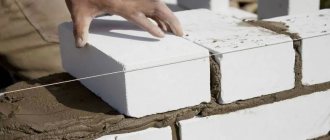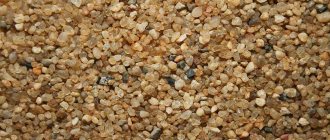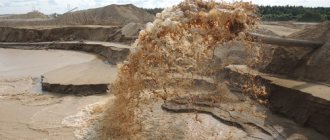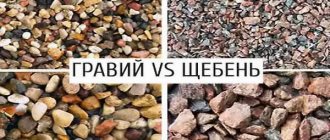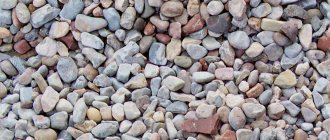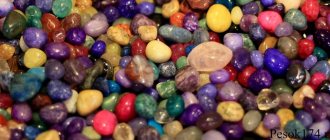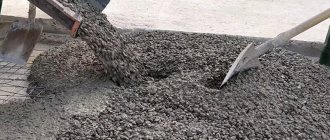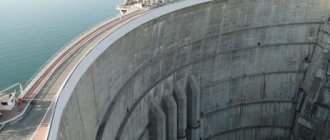It is safe to say that sand is an integral part of any of the known building mixtures. The production of one or another binder or decorative composition is carried out based on their type of fraction and on its basis. The scope of application of this natural material, familiar to everyone, even non-specialists, is quite wide.
Sand is the most well-known and reusable material for construction, which is used now, because without it it is impossible to correctly conduct all stages of construction work, from laying the foundation to interior decoration. At the same time, sand fractions vary significantly, which is why the variability of its use expands.
Coarse sand, which will be discussed below, can be used in landscape design, public utilities, and construction. It will be indispensable in the production of porcelain, glass, earthenware, asphalt, and for water purification.
What is sand?
Sand
is usually called a certain bulk material that can be formed due to the possibility of expansion of rock or which is obtained as a result of artificial grinding. But because of the size of the grains resulting from crushing, we are accustomed to distinguishing between coarse sand and fine sand. Coarse sand has certain sizes, from 2.4 to 3 mm.
The composition of the building material assumes a small presence of various impurities - stones, clay and rock dust. The qualitative characteristics of sand directly depend on the percentage of elements contained in it. The lower the percentage, the better the quality of the sand. The State Standardization System applies two regulations for construction sand:
- GOST 8736 93.
Coarse material is intended to fill concrete of very different densities. It is used in the production of asphalt and other bulk mixtures intended for road use. As a rule, coarse sand, falling under GOST 8736 93, is used in heavy industry and other areas that are associated with monolithic production.
As for finishing work, coarse sand GOST 8736 93 is unsuitable due to the fact that it contains quite a lot of different impurities that are needed for better adhesion with other components.
Coarse sand can be fully assessed by its high-quality adhesion to the surface and the formation of a rough coating, which is of enormous importance for road production.
- GOST 22856-89.
This is sand of coarse and fine fractions. It can be obtained by crushing natural stone, or by extracting it from channels and river mouths. This is a high-quality building binder in the production of bricks, earthenware, plaster and other products. In construction, coarse washed sand is most valued because it contains very few impurities and is one of the components of decorative materials.
True, there is also a drawback - smoothness, which is why particles in the solution settle quickly. Therefore, the mixture must be constantly thoroughly mixed.
Application of quarry sand
- Construction of roads, buildings, reinforced concrete products;
- Manufacturing of foundations;
- Production of concrete and bricks;
- Preparation of plaster, mortars for foundation laying;
- Backfilling of trenches;
- Leveling the relief of the land plot;
- Landscape design.
Advantages
- Low cost;
- Simple extraction process;
- One of the most common types of sand.
Flaws
- Low quality;
- High content of various impurities;
- Requires additional cleaning
How to characterize it?
Coarse sand
That's what coarse sand is. The characteristics of this bulk material will help you understand what it is and where it can be used.
So, sand is a kind of mixture of minerals and rocks that have completely different sizes and do not stick together. This is a natural material, because it can be obtained either in a quarry or from the bottom of a river. As a rule, this material can be washed or sifted. Coarse sand requires certain standard sizes - 2.4-3 mm. But you need to know that quarry and river sand are different in composition: this is because river sand has no impurities at all, its cost is an order of magnitude higher.
The cost is also affected by the fact that mining occurs using a high-tech machine. If the sand contains impurities of some substances, for example, clay, then it needs to be washed. The sifting procedure is recommended only if any large particles are found in it - debris or stones. Sorting of the material occurs only after this.
The characteristics of the sand are such that if it meets the quality, it must meet all the requirements set for it, which are applicable to the conditions of use. If we are talking about the production of, for example, road surfaces, then the actual grain density should be 2.2-2.8 g/cc; impurities should be no more than 9%; since this is coarse sand, it should be from 2.6 mm and above; the color is most often gray, less often light.
If the characteristics are considered for the production of plastering or finishing work, then something else is taken into account: impurities should be no more than half a percent; grain - 2.2-3.0 mm; color can range from gray to light yellow.
Types of material
We have 4 most popular types of sand on sale:
- Career . This sand is not subject to additional processing, therefore it has the lowest price. It is rough and has large grains; it contains inclusions of clay, pebbles, and salt.
- Seeded . It has a more uniform structure and consists of small grains, due to which it has an increased bulk density and wear resistance. Of course, its price will be slightly higher than unprocessed.
- Washed . It is extracted by washing sand from quarries. This option is more expensive because the washing process is more expensive.
- River . The extraction of such sand is carried out in river beds, where it is naturally purified by water. It is characterized by a low content of clay impurities and has rounded, polished grains.
The cost of the order depends on the selected type of sand, the volume of the ordered batch and the distance of your facility from our quarries/transfer points (if delivery is required).
How to apply in construction?
Sand in construction
Coarse sand is an absolutely natural, environmentally friendly material. As a rule, it is used for construction - when it is necessary to build a foundation or make concrete. The material extracted from the river is used when paving the road, because it is the basis of the road surface.
Coarse sand, having certain properties, can strengthen the strength of any concrete or reinforced concrete structure. It is also used when it is necessary to lay paving slabs so that there are no puddles left on it. By the way, sand is also needed to make such tiles.
Construction coarse sand is used in the production of concrete or cinder block; it is also necessary in order to make a screed from cement, plaster mortar, arranging a foundation or for finishing work.
For the procedures mentioned just above, you should use exclusively river sand, since it contains no impurities and is an excellent filler for the solution.
Coarse sand is perfect for brick production. In addition, it is applicable for making a solution from which blocks will subsequently be formed. It is thanks to sand that a fairly strong block skeleton is obtained, making it much more resistant to various external influences.
Using coarse material – why is it needed?
Coarse sand is actively used in repairs and construction. It is indispensable in the construction of foundations and concrete production. Natural construction sand, mined from the river bottom, has no real replacement in the process of covering highways with asphalt. Almost all types of road surfaces are made on the basis of large fraction material.
Production of concrete from coarse sand
Construction sand is also good for:
- production of cinder blocks (in this case, rubble stone and fine crushed stone are used together with it);
- increasing the strength characteristics of concrete and reinforced concrete structures;
- formation of plaster and finishing mixtures;
- obtaining cement screeds;
- production and installation of paving slabs.
Installation of paving slabs
In addition, the described construction sand has recently been actively used in brick factories and enterprises that produce modern blocks for the construction of houses and buildings. It guarantees a truly strong “skeleton” of bricks and blocks, which due to this become highly resistant to various external influences.
Please note that coarse sand for the purposes mentioned above can only be river sand. Quarry building material is usually used in other areas. We will talk about them below.
Supporting roles of sand
Since coarse sand is not bound by water, it can be used in various solutions. The solution gains strength and is ensured by the least shrinkage. In addition, sand is not afraid of chemicals; it perfectly fills various mixtures, making them much stronger and without distorting their original properties.
Due to the fact that sand has an absolutely neutral color, it is often used in landscape design (even though it can easily crumble). You can use it to make paths or slides on your site. Sand cannot rot: it can allow air to pass through very well, and it will not retain moisture.
In most construction and installation work (not forgetting about finishing), coarse sand is used. You cannot do without it when erecting brick walls or in order to equip a drainage system. As a rule, a cushion is made from sand to protect the foundation from unnecessary moisture. This type of material is also suitable for constructing septic tanks.
Application
Sand is very often used in construction. It adds volume, strength and stability to other materials such as asphalt, concrete, mortar, plaster, cement and screed.
Quarry sand is suitable for mixing concrete and making reinforced concrete products. It can also be used for railway embankments, soil enrichment and other purposes.
Seeded sand can be used for dry construction and gypsum mixtures, making mortar for building roads, foundations, and well rings. It is purchased by utility companies for sprinkling roads in icy conditions and for filtration at wastewater treatment plants.
Products made from washed sand are very durable. It is used to make reinforced concrete and concrete mortars, bricks, plaster mixtures, and paving slabs. It is also suitable for filling playgrounds, decorating landscapes and making glass.
River is used for brickwork and plaster, making mortars. It can also be mixed with plant soil to improve the properties of the latter.
You can order construction sand with delivery throughout Moscow and the region by phone. We are direct suppliers, we deliver goods promptly, without delays. It is possible to ship the material on the day of placing the order, subject to availability of available vehicles.
Price policy
The price of coarse sand in bags for any construction work may vary depending on the fraction and processing method. Therefore, you should especially carefully consider any offers that come your way on the construction market. After all, you can almost always find a discount, or delivery will be included in the price. For work, you should choose the type of sand size module that can reveal its qualities in the best possible way. If a potential client is not very knowledgeable about this issue, consultants will always come to his aid and advise him on what is best to purchase. It is thanks to them that the customer will be satisfied with the purchase and the price-quality ratio. By the way, the rule always works: wholesale will be cheaper than retail.
If we consider Moscow prices (with the delivery service of building materials), then the price for one cubic meter of coarse sand can fluctuate between approximately 790-900 rubles. Such a difference (and quite noticeable for the wallet) indicates how high quality the material is and what the capabilities of the manufacturer are.
If the buyer also agrees on delivery, then he must receive an appropriate document containing information about the fraction and processing method, the place of extraction, and the actual density of the grains. It is already clear here that a huge number of purification processes will not be able to make the product cheaper. But it’s also impossible, and you shouldn’t rush into saving too much, especially when it comes to appearance or load-bearing structures.
Application of river sand
- Construction of roads and highways;
- Landscape design (as a basis for bricks, when designing flower beds, paths, etc.);
- Add to soil and peat mixtures;
- Production of paving slabs;
- Construction of foundations;
- Manufacturing of bricks, concrete blocks and tiles;
- Preparation of concrete and plaster mortars;
- Drainage and water disposal systems;
- Basis for dyes and grout mixtures.
- Arrangement of children's sandboxes and aquariums.
Advantages
- Not subject to rotting processes and aggressive environmental influences;
- It is considered an environmentally friendly and safe product;
- Has high moisture permeability and good sound insulation;
- Meets most technical requirements.
- Does not contain impurities, clay particles and other organic substances;
- Thanks to natural polishing, it has a perfectly smooth shape.
Flaws
- High price;
- To make cement-sand mortars with river sand, more thorough mixing and a large amount of cement are required.
Buy sand in Moscow
I hereby freely, by my own will and in my own interest, give my consent to IP Tsurikov Alexander Evgenievich, located at 627750, Tyumen region, Ishimsky district, Plodopitomnik village, st. Svetlaya, 2, 1 (hereinafter referred to as the Operator) for automated and non-automated processing of their personal data in accordance with the following list:
- name, telephone number, email address and other individual means of communication specified when filling out all forms on the website https://vsembeton-msk.ru (hereinafter referred to as the Site), namely: Calculate the cost of the order
- writing reviews;
- using feedback services with the Site Administration;
for the purposes of providing information services and ordering concrete, providing relevant advertising information and optimizing advertising.
I also give my consent to the Operator providing my personal data to third parties and to carrying out cross-border transfer of personal data to achieve the stated purposes of processing personal data.
In order to ensure the implementation of legal requirements in the field of personal data processing, the Operator can:
- carry out the processing of personal data by collecting, storing, systematizing, accumulating, changing, clarifying, using, distributing, depersonalizing, blocking, destroying personal data;
- use an automated method of processing personal data via the Internet;
This consent comes into force from the moment of confirmation and is valid for 5 years, unless otherwise provided by the current legislation of the Russian Federation.
Withdrawal of consent to the processing of personal data is carried out by sending a written application to the legal address of the Operator.
I confirm that I am aware of the right to withdraw my consent by drawing up an appropriate written document that can be sent by me to the Operator. In the event of my withdrawal of consent to the processing of personal data, the Operator has the right to continue processing personal data without my consent if there are grounds specified in paragraphs 2-11 of part 1 of article 6, part 2 of article 10 and part 2 of article 11 of the Federal Law of July 27, 2006. No. 152-FZ “On Personal Data”.
Which sand is better?
Each sand has its own advantages and disadvantages, so the answer is ambiguous. Which sand is better to choose depends on the purpose of its use. After all, it happens that in certain cases you can get by with quarry sand, rather than high-quality and expensive river sand.
Preparation of building mixtures:
the addition of quarry sand will significantly reduce the cost of concrete and the construction itself, but the quality in this case will be worse (the composition will be heterogeneous, the plaster will begin to delaminate, and the finish will quickly take on an unpresentable appearance).
Filling holes in the garden
: in this case, the quality of the sand will not matter at all; accordingly, the cheapest and most accessible type of sand – quarry sand – is best suited for this.
Creating a pillow for the foundation:
It is best to use large-sized dry river sand, which contains gravel and practically no clay, in accordance with the technical requirements. If the soil on which the building will be built is stable, then washed quarry sand of medium or large size can be used.
Production and laying of paving slabs
: The main thing here is the purity of the material used. Therefore, in order for the pavement to be strong and durable, it is best to use clean river sand. Washed quarry is also suitable - it lays more tightly on the ground and practically does not shrink under the weight of the tiles, plus it is much cheaper.
Installation of reinforced concrete structures
-
it is better to use coarse river sand.
Plaster:
For textured, mosaic and any other decorative plaster, you need to use only fine, clean river sand, otherwise the plaster will lie unevenly and you won’t be able to get a voluminous texture. For ordinary plaster, an additive made from washed quarry sand of a fine fraction, which contains clay impurities, is suitable, which will improve the elasticity of the mixture, the plaster will be easier to apply, and it will last longer on the walls.
Floor screed:
Only clean river sand is used. The main thing in this case is the size of the grains of sand. For screeding, a fraction of 1.5-2 mm is required.
Blind area:
For its construction, it is better to use fine-sized alluvial quarry sand.
Garden:
sand is added to the soil to improve its structure. Coarse-grained river sand is best suited for such purposes, because... it does not contain clay impurities.
Mixing solutions:
sand with clay is suitable - this will make the solution more elastic and mobile.
